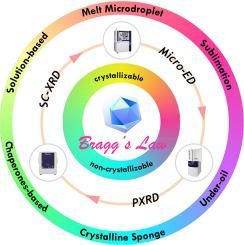当前位置:
X-MOL 学术
›
Coord. Chem. Rev.
›
论文详情
Our official English website, www.x-mol.net, welcomes your feedback! (Note: you will need to create a separate account there.)
Current trends and advancements in crystallization and single-crystal structural analysis of small molecules
Coordination Chemistry Reviews ( IF 20.3 ) Pub Date : 2024-06-25 , DOI: 10.1016/j.ccr.2024.216035 Yuntian Xiao , Chuanhua Wu , Ling Zhou , Patrick Commins , Liang Li , Panče Naumov , Qiuxiang Yin
Coordination Chemistry Reviews ( IF 20.3 ) Pub Date : 2024-06-25 , DOI: 10.1016/j.ccr.2024.216035 Yuntian Xiao , Chuanhua Wu , Ling Zhou , Patrick Commins , Liang Li , Panče Naumov , Qiuxiang Yin

|
The advancement of single-crystal structural analysis has emerged as a pivotal technology surpassing spectroscopic methods in revealing the intricate structural details of organic small molecules, including crystal packing and stereochemical configurations. It plays a critical role across scientific domains such as chemistry, biology, agronomy, and medicine. Traditional single-crystal X-ray diffraction (SCXRD) has always been restricted by its stringent requirements on the physical state, size, and quality of crystals. This review discusses the arsenal of equipment and theoretical techniques for obtaining single-crystal structures, including SCXRD, PXRD & CSP, and more recently, Micro-ED. It further explores the significant crystal growth techniques based on three foundational methods: solution-based crystallization, melt crystallization, and sublimation crystallization. Detailed discussion is provided on the crystallizability of molecules and the refinement of crystal growth methods. Specifically, for crystallizable analytes, a combination of crystal growth enhancement techniques and high-throughput technologies (under-oil) can compensate for poor crystallinity, small size, and defects under normal conditions. For molecules inherently resistant to crystallization, a “crystallization chaperone”, such as a MOFs as a crystalline sponge or tetraaryladamantane as a cocrystallization chaperone, can determine absolute configurations. Looking ahead, this review emphasizes the potential of artificial intelligence and machine learning approaches for crystal growth and structural prediction. The development of integrated analysis strategies combining SCXRD, PXRD, and Micro-ED is identified as a future trend for providing comprehensive structural insights. This review highlights the significance of advancements in single-crystal structural analysis techniques, paving the way for groundbreaking innovations in molecular design and materials science, and predicts a bright future for the field with new technologies.
中文翻译:

小分子结晶和单晶结构分析的当前趋势和进展
单晶结构分析的进步已成为超越光谱方法的关键技术,可揭示有机小分子复杂的结构细节,包括晶体堆积和立体化学构型。它在化学、生物学、农学和医学等科学领域发挥着至关重要的作用。传统的单晶X射线衍射(SCXRD)一直受到其对晶体的物理状态、尺寸和质量的严格要求的限制。这篇综述讨论了获得单晶结构的设备和理论技术,包括 SCXRD、PXRD 和 CSP,以及最近的 Micro-ED。它进一步探索了基于三种基本方法的重要晶体生长技术:溶液结晶、熔融结晶和升华结晶。详细讨论了分子的结晶性和晶体生长方法的改进。具体来说,对于可结晶分析物,晶体生长增强技术和高通量技术(油下)的结合可以弥补正常条件下结晶度差、尺寸小和缺陷。对于本质上抗结晶的分子,“结晶伴侣”,例如作为结晶海绵的 MOF 或作为共结晶伴侣的四芳基金刚烷,可以确定绝对构型。展望未来,这篇综述强调了人工智能和机器学习方法在晶体生长和结构预测方面的潜力。结合 SCXRD、PXRD 和 Micro-ED 的集成分析策略的开发被认为是提供全面结构见解的未来趋势。 这篇综述强调了单晶结构分析技术进步的重要性,为分子设计和材料科学的突破性创新铺平了道路,并预测了新技术领域的光明未来。
更新日期:2024-06-25
中文翻译:

小分子结晶和单晶结构分析的当前趋势和进展
单晶结构分析的进步已成为超越光谱方法的关键技术,可揭示有机小分子复杂的结构细节,包括晶体堆积和立体化学构型。它在化学、生物学、农学和医学等科学领域发挥着至关重要的作用。传统的单晶X射线衍射(SCXRD)一直受到其对晶体的物理状态、尺寸和质量的严格要求的限制。这篇综述讨论了获得单晶结构的设备和理论技术,包括 SCXRD、PXRD 和 CSP,以及最近的 Micro-ED。它进一步探索了基于三种基本方法的重要晶体生长技术:溶液结晶、熔融结晶和升华结晶。详细讨论了分子的结晶性和晶体生长方法的改进。具体来说,对于可结晶分析物,晶体生长增强技术和高通量技术(油下)的结合可以弥补正常条件下结晶度差、尺寸小和缺陷。对于本质上抗结晶的分子,“结晶伴侣”,例如作为结晶海绵的 MOF 或作为共结晶伴侣的四芳基金刚烷,可以确定绝对构型。展望未来,这篇综述强调了人工智能和机器学习方法在晶体生长和结构预测方面的潜力。结合 SCXRD、PXRD 和 Micro-ED 的集成分析策略的开发被认为是提供全面结构见解的未来趋势。 这篇综述强调了单晶结构分析技术进步的重要性,为分子设计和材料科学的突破性创新铺平了道路,并预测了新技术领域的光明未来。






































 京公网安备 11010802027423号
京公网安备 11010802027423号